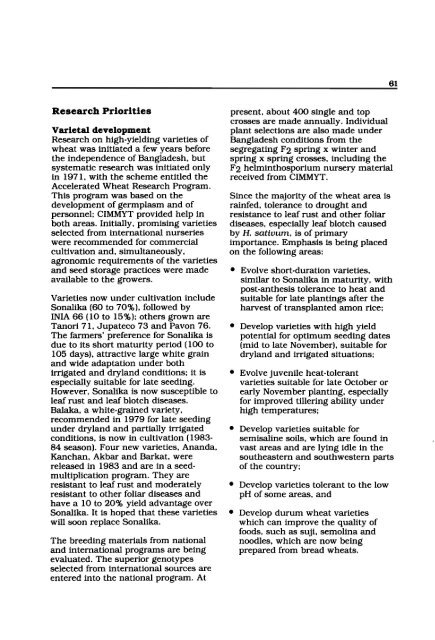the Symposium on Wheats for More Tropical Environments - cimmyt
the Symposium on Wheats for More Tropical Environments - cimmyt
the Symposium on Wheats for More Tropical Environments - cimmyt
- No tags were found...
Create successful ePaper yourself
Turn your PDF publications into a flip-book with our unique Google optimized e-Paper software.
61Research PrioritiesVarietal developmentResearch <strong>on</strong> high-yielding varieties ofwheat was initiated a few years be<strong>for</strong>e<str<strong>on</strong>g>the</str<strong>on</strong>g> independence of Bangladesh, butsystematic research was initiated <strong>on</strong>lyin 1971, with <str<strong>on</strong>g>the</str<strong>on</strong>g> scheme entitled <str<strong>on</strong>g>the</str<strong>on</strong>g>Accelerated Wheat Research Program.This program was based <strong>on</strong> <str<strong>on</strong>g>the</str<strong>on</strong>g>development of germplasm and ofpers<strong>on</strong>nel; CIMMYT provided help inboth areas. Initially, promising varietiesselected from internati<strong>on</strong>al nurserieswere recommended <strong>for</strong> commercialcultivati<strong>on</strong> and, simultaneously,agr<strong>on</strong>omic requirements of <str<strong>on</strong>g>the</str<strong>on</strong>g> varietiesand seed storage practices were madeavailable to <str<strong>on</strong>g>the</str<strong>on</strong>g> growers.Varieties now under cultivati<strong>on</strong> includeS<strong>on</strong>alika (60 to 70%), followed byINIA 66 (10 to 15%); o<str<strong>on</strong>g>the</str<strong>on</strong>g>rs grown areTanori 71, Jupateco 73 and Pav<strong>on</strong> 76.The farmers' preference <strong>for</strong> S<strong>on</strong>alika isdue to its short maturity period (100 to105 days), attractive large white grainand wide adaptati<strong>on</strong> under bothirrigated and dryland c<strong>on</strong>diti<strong>on</strong>s; it isespecially suitable <strong>for</strong> late seeding.However, S<strong>on</strong>alika is now susceptible toleaf rust and leaf blotch diseases.Balaka, a white-grained variety,recommended in 1979 <strong>for</strong> late seedingunder dryland and partially irrigatedc<strong>on</strong>diti<strong>on</strong>s, is now in cultivati<strong>on</strong> (198384 seas<strong>on</strong>). Four new varieties, Ananda,Kanchan, Akbar and Barkat. werereleased in 1983 and are in a seedmultiplicati<strong>on</strong>program. They areresistant to leaf rust and moderatelyresistant to o<str<strong>on</strong>g>the</str<strong>on</strong>g>r foliar diseases andhave a 10 to 20% yield advantage overS<strong>on</strong>alika. It is hoped that <str<strong>on</strong>g>the</str<strong>on</strong>g>se varietieswill so<strong>on</strong> replace S<strong>on</strong>alika.The breeding materials from nati<strong>on</strong>aland internati<strong>on</strong>al programs are beingevaluated. The superior genotypesselected from internati<strong>on</strong>al sources areentered into <str<strong>on</strong>g>the</str<strong>on</strong>g> nati<strong>on</strong>al program. Atpresent, about 400 single and topcrosses are made annually. Individualplant selecti<strong>on</strong>s are also made underBangladesh c<strong>on</strong>diti<strong>on</strong>s from <str<strong>on</strong>g>the</str<strong>on</strong>g>segregating F2 spring x winter andspring x spring crosses, including <str<strong>on</strong>g>the</str<strong>on</strong>g>F2 helminthosporium nursery materialreceived from CIMMYT.Since <str<strong>on</strong>g>the</str<strong>on</strong>g> majority of <str<strong>on</strong>g>the</str<strong>on</strong>g> wheat area israinfed, tolerance to drought andresistance to leaf rust and o<str<strong>on</strong>g>the</str<strong>on</strong>g>r foliardiseases, especially leaf blotch causedby H. sattvum, is of primaryimportance. Emphasis is being placed<strong>on</strong> <str<strong>on</strong>g>the</str<strong>on</strong>g> follOWing areas:• Evolve short-durati<strong>on</strong> varieties,similar to S<strong>on</strong>alika in maturity, withpost-an<str<strong>on</strong>g>the</str<strong>on</strong>g>sis tolerance to heat andsuitable <strong>for</strong> late plantings after <str<strong>on</strong>g>the</str<strong>on</strong>g>harvest of transplanted am<strong>on</strong> rice;• Develop varieties with high yieldpotential <strong>for</strong> optimum seeding dates(mid to late November), suitable <strong>for</strong>dryland and irrigated situati<strong>on</strong>s;• Evolve juvenile heat-tolerantvarieties suitable <strong>for</strong> late October orearly November planting, especially<strong>for</strong> improved tillering ability underhigh temperatures;• Develop varieties suitable <strong>for</strong>semisaline soils, which are found invast areas and are lying idle in <str<strong>on</strong>g>the</str<strong>on</strong>g>sou<str<strong>on</strong>g>the</str<strong>on</strong>g>astern and southwestern partsof <str<strong>on</strong>g>the</str<strong>on</strong>g> country;• Develop varieties tolerant to <str<strong>on</strong>g>the</str<strong>on</strong>g> lowpH of some areas, and• Develop durum wheat varietieswhich can improve <str<strong>on</strong>g>the</str<strong>on</strong>g> quality offoods. such as sUji, semolina andnoodles, which are now beingprepared from bread wheats.

















